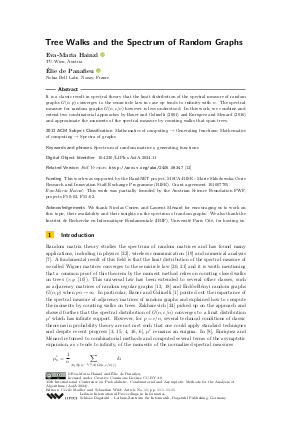Tree Walks and the Spectrum of Random Graphs
Authors
Eva-Maria Hainzl  ,
Élie de Panafieu
,
Élie de Panafieu 
-
Part of:
Volume:
35th International Conference on Probabilistic, Combinatorial and Asymptotic Methods for the Analysis of Algorithms (AofA 2024)
Part of: Series: Leibniz International Proceedings in Informatics (LIPIcs)
Part of: Conference: International Conference on Probabilistic, Combinatorial and Asymptotic Methods for the Analysis of Algorithms (AofA) - License:
 Creative Commons Attribution 4.0 International license
Creative Commons Attribution 4.0 International license
- Publication Date: 2024-07-18
File

PDF
LIPIcs.AofA.2024.11.pdf
- Filesize: 1.38 MB
- 15 pages
Document Identifiers
Related Versions
- Full Version http://arxiv.org/abs/2405.08347
Subject Classification
ACM Subject Classification
- Mathematics of computing → Generating functions
- Mathematics of computing → Spectra of graphs
Keywords
- Spectrum of random matrices
- generating functions
Metrics
- Access Statistics
-
Total Accesses (updated on a weekly basis)
0PDF Downloads0Metadata Views
Abstract
It is a classic result in spectral theory that the limit distribution of the spectral measure of random graphs G(n,p) converges to the semicircle law in case np tends to infinity with n. The spectral measure for random graphs G(n,c/n) however is less understood. In this work, we combine and extend two combinatorial approaches by Bauer and Golinelli (2001) and Enriquez and Menard (2016) and approximate the moments of the spectral measure by counting walks that span trees.
Cite As Get BibTex
Eva-Maria Hainzl and Élie de Panafieu. Tree Walks and the Spectrum of Random Graphs. In 35th International Conference on Probabilistic, Combinatorial and Asymptotic Methods for the Analysis of Algorithms (AofA 2024). Leibniz International Proceedings in Informatics (LIPIcs), Volume 302, pp. 11:1-11:15, Schloss Dagstuhl – Leibniz-Zentrum für Informatik (2024)
https://doi.org/10.4230/LIPIcs.AofA.2024.11
BibTex
@InProceedings{hainzl_et_al:LIPIcs.AofA.2024.11,
author = {Hainzl, Eva-Maria and de Panafieu, \'{E}lie},
title = {{Tree Walks and the Spectrum of Random Graphs}},
booktitle = {35th International Conference on Probabilistic, Combinatorial and Asymptotic Methods for the Analysis of Algorithms (AofA 2024)},
pages = {11:1--11:15},
series = {Leibniz International Proceedings in Informatics (LIPIcs)},
ISBN = {978-3-95977-329-4},
ISSN = {1868-8969},
year = {2024},
volume = {302},
editor = {Mailler, C\'{e}cile and Wild, Sebastian},
publisher = {Schloss Dagstuhl -- Leibniz-Zentrum f{\"u}r Informatik},
address = {Dagstuhl, Germany},
URL = {https://drops.dagstuhl.de/entities/document/10.4230/LIPIcs.AofA.2024.11},
URN = {urn:nbn:de:0030-drops-204466},
doi = {10.4230/LIPIcs.AofA.2024.11},
annote = {Keywords: Spectrum of random matrices, generating functions}
}
Author Details
Funding
This work was supported by the RandNET project, MSCA-RISE - Marie Skłodowska-Curie Research and Innovation Staff Exchange Programme (RISE), Grant agreement 101007705.
- Hainzl, Eva-Maria: This work was partially founded by the Austrian Science Foundation FWF, projects F50-02, F55-02.
Acknowledgements
We thank Nicolas Curien and Laurent Ménard for encouraging us to work on this topic, their availability and their insights on the spectrum of random graphs. We also thank the Institut de Recherche en Informatique Fondamentale (IRIF), Université Paris Cité, for hosting us.
References
- Michel Bauer and Olivier Golinelli. Random incidence matrices: Moments of the spectral density. Journal of Statistical Physics, 103:301-337, 2001. URL: https://doi.org/10.1023/A:1004879905284.
-
François Bergeron, Gilbert Labelle, and Pierre Leroux. Combinatorial Species and Tree-like Structures. Cambridge University Press, 1997.

- Charles Bordenave, Marc Lelarge, and Justin Salez. The rank of diluted random graphs. Annals of Probability, 39(3):1097-1121, 2011. URL: https://doi.org/10.1214/10-AOP567.
- Charles Bordenave, Arnab Sen, and Bálint Virág. Mean quantum percolation. Journal of the European Mathematical Society, 19(12):3679-3707, 2017. URL: https://doi.org/10.4171/JEMS/750.
- JT Chayes, L Chayes, Judy R Franz, James P Sethna, and SA Trugman. On the density of state for the quantum percolation problem. Journal of Physics A: Mathematical and General, 19(18):L1173, 1986. URL: https://doi.org/10.1088/0305-4470/19/18/011.
- Simon Coste and Justin Salez. Emergence of extended states at zero in the spectrum of sparse random graphs. Annals of Probability, 49(4), 2021. URL: https://doi.org/10.1214/20-AOP1499.
- Alan Edelman and N Raj Rao. Random matrix theory. Acta numerica, 14:233-297, 2005. URL: https://doi.org/10.1017/S0962492904000236.
- Nathanaël Enriquez and Laurent Ménard. Spectra of large diluted but bushy random graphs. Random Structures & Algorithms, 49(1):160-184, 2016. URL: https://doi.org/10.1002/rsa.20618.
- Philippe Flajolet and Robert Sedgewick. Analytic Combinatorics. Cambridge University Press, 2009. URL: http://www.cambridge.org/uk/catalogue/catalogue.asp?isbn=9780521898065.
- Zoltán Füredi and János Komlós. The eigenvalues of random symmetric matrices. Combinatorica, 1:233-241, 1981. URL: https://doi.org/10.1007/BF02579329.
- Ira M Gessel. Lagrange inversion. Journal of Combinatorial Theory, Series A, 144:212-249, 2016. URL: https://doi.org/10.1016/j.jcta.2016.06.018.
- Eva-Maria Hainzl and Élie de Panafieu. Tree walks and the spectrum of random graphs. arXiv, arXiv:2405.08347:26, 2024. URL: https://doi.org/10.48550/arXiv.2405.08347.
- Brendan D McKay. The expected eigenvalue distribution of a large regular graph. Linear Algebra and its applications, 40:203-216, 1981. URL: https://doi.org/10.1016/0024-3795(81)90150-6.
- Frank Olver. Asymptotics and special functions. CRC Press, 1997. URL: https://doi.org/10.1201/9781439864548.
- Justin Salez. Every totally real algebraic integer is a tree eigenvalue. Journal of Combinatorial Theory, Series B, 111:249-256, 2015. URL: https://doi.org/10.1016/j.jctb.2014.09.001.
- Justin Salez. Spectral atoms of unimodular random trees. Journal of the European Mathematical Society (EMS Publishing), 22(2), 2020. URL: https://doi.org/10.4171/JEMS/923.
-
N.J.A. Sloane. sequence a294439. The on-line encyclopedia of integer sequences, 2017.

- Linh V Tran, Van H Vu, and Ke Wang. Sparse random graphs: Eigenvalues and eigenvectors. Random Structures & Algorithms, 42(1):110-134, 2013. URL: https://doi.org/10.1002/rsa.20406.
- Antonia M Tulino, Sergio Verdú, et al. Random matrix theory and wireless communications. Foundations and Trendsregistered in Communications and Information Theory, 1(1):1-182, 2004. URL: https://doi.org/10.1561/0100000001.
- Eugene P Wigner. Characteristic vectors of bordered matrices with infinite dimensions. Annals of Mathematics, pages 548-564, 1955. URL: https://doi.org/10.2307/1970079.
- Eugene P Wigner. On the distribution of the roots of certain symmetric matrices. Annals of Mathematics, 67(2):325-327, 1958. URL: https://doi.org/10.2307/1970008.
- Eugene P Wigner. Random matrices in physics. SIAM review, 9(1):1-23, 1967. URL: https://doi.org/10.1137/1009001.
-
Edward M Wright. The number of connected sparsely edged graphs I-III. Journal of Graph Theory, 1977-80.

- Inna Zakharevich. A generalization of wigner’s law. Communications in Mathematical Physics, 268:403-414, 2006. URL: https://doi.org/10.1007/s00220-006-0074-5.
